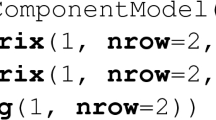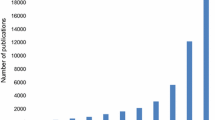Abstract
Meta-analysis of behavioral genetic studies would provide (i) tighter confidence intervals around parameter estimates, (ii) clarification of apparently discrepant study findings, and (iii) a mechanism for analyzing systematic causes of between-study differences. We examined some key issues that arise in the meta-analysis of categorical phenotypes. Data were simulated under a multifactorial threshold model that assumed an underlying normal liability distribution, and summary statistics (probandwise concordance rate, recurrence risk ratio, odds ratio, kappa) compared for given values of the liability correlation between relatives and given population prevalence. Although the odds ratio and kappa statistic performed well at moderate to high values of the population prevalence (15–50%), at low values all of these statistics were sensitive to overall prevalence. In cases where the assumption of a multifactorial threshold model is reasonable, direct estimation of genetic and environmental parameters from the summary statistics from all studies appears to be a preferable strategy. For cases where data from non-randomly ascertained samples are used, the impact of misspecification of the model for ascertainment was examined. For some parameter values, such misspecifications led to quite serious biases to estimates of genetic and environmental parameters. These biases varied in complex ways as a function of research design and of the true causes of variation in the population, so that the same misspecification could lead to an overestimate of the importance of genetic influences in twin data but an underestimation in adoption data or to an overestimate of the importance of genetic effects from twin data if shared environmental as well as genetic influences were simulated but an underestimate of genetic effects if shared environmental effects were assumed unimportant. These complexities emphasize the importance of being sensitive to the effects of misspecifying ascertainment corrections in any meta-analysis of behavioral genetic data.
Similar content being viewed by others
REFERENCES
Brennan, P. A., and Mednick, S. A. (1993). Genetic perspectives on crime. Acta Psychiatr. Scand. 370 (Suppl.): 19-26.
Carey, G. (1992). Twin imitation for antisocial behavior: Implications for genetic and family environment research. J. Abnorm. Psychol 101:18-25.
Christiansen, K. O. (1974). Seriousness of criminality and concordance among Danish twins. In Hood, R. (ed.) Crime, Criminology and Public Policy, Heinemann, London, pp. 63-77.
Christiansen, K. O. (1977). A preliminary study of criminality among twins. In Mednick, S., and Christiansen, K. O. (eds.), Biosocial Bases of Criminal Behavior, Gardner Press, New York, pp. 89-108.
Dalgaard, O. S., and Kringlen, E. (1976). A Norwegian twin study of criminality. Br. J. Criminal. 17:213-232.
DiLalla, L. F., and Gottesman, I. I. (1989). Heterogeneity of causes for delinquency and criminality: Lifespan perspectives. Dev. Psychopathol. 1:339-349.
Eaves, L. J., and Eysenck, H. J. (1980). The genetics of smoking. In Eysenck, H. J. (ed.), The Causes and Effects of Smoking, Maurice Temple Smith, London, London, pp. 130-134.
Eaves, L. J., Last, K. A., Young, P. A., and Martin, N. G. (1978). Model-fitting approaches to the analysis of human behavior. Heredity 41:249-320.
Edwards, J. H. (1969). Familial predisposition in men. Br. Med. Bull. 25:58-64.
Heath, A. C. (1995). Genetic influences on alcoholism risk: A review of adoption and twin studies. Alcohol Health Res. World 19:166-171.
Heath, A. C., Slutske, W. S., Bucholz, K. K., Madden, P. A. F., and Martin, N. G. (1997). Behavioral genetic methods in prevention research: an overview. In Bryant, K., Windle, M., and West, S. G. (eds.), Methodological Advances from Alcohol and Substance Abuse Research, American Psychological Association, Washington, DC, pp. 123-163.
Heath, A. C., Madden, P. A. F., and Martin, N. G. (1998). Statistical methods in genetic research on smoking. Stat. Methods Med. Res. 7:1-22.
Hunter, J. E., and Schmidt, F. L. (1990). Methods of Meta-Analysis: Correcting Error and Bias in Research Findings, Sage, Newbury Park, CA.
Hunter, J. E., Schmidt, F. L., and Johnson, G. B. (1982). Meta-Analysis: Cumulating Research Findings Across Studies, Sage, Beverly Hills, CA.
Kessler, R. C., McGonagle, K. A., Zhoa, S., Nelson, C. B., Hughes, M., Eshleman, S., Wittchen, H., and Kendler, K. S. (1994). Lifetime and 12-month prevalence of DSM-III-R psychiatric disorders in the United States. Arch. Gen. Psychiatry 51:8-19.
Kraemer, H. C. (1997). What is the "right" statistical measure of twin concordance (or diagnostic reliability and validity)? Arch. Gen. Psychiatry 54:1121-1125.
Kranz, F. (1937). Untersuchungen an Zwillingen in Fursorgeerzienunganstalten. Z. Indukt. Abstammungs-Vererbungslehre 73:508-512.
Lange, J. (1931). Crime as Destiny, Allen and Unwin, London.
Little, R. J. A., and Rubin, D. B. (1987). Statistical Analysis with Missing Data, Wiley, New York.
Loehlin, J. C. (1978). Heredity-environment analyses of Jenck's IQ correlations. Behav. Genet. 8:415-436.
McGue, M., Pickens, R. W., and Svikis, D. S. (1992). Sex and age effects on the inheritance of alcohol problems: A twin study. J. Abnorm. Psychol. 101:3-17.
McGuffin, P., and Gottesman, I. I. (1985). Genetic influences on normal and abnormal development. In Rutter, M., and Hersov, L. (eds.), Child and Adolescent Psychiatry: Modern Approaches, Blackwell Scientific, Oxford, pp. 17-33.
McGuffin, P., Katz, R., Watkins, S., and Rutherford, J. (1996). A hospital-based twin register of the heritability of DSM-IV unipolar depression. Arch. Gen. Psychiatry 53:129-136.
Neale, M. C. (1997). MX: Statistical Modeling, 4th ed., Box 126 MCV, Department of Psychiatry, Richmond, VA.
Reich, T., James, J. W., and Morris, C. A. (1972) The use of multiple thresholds in determining the mode of transmission of semicontinuous traits. Ann. Hum. Genet. 36:163-184.
Risch, N. (1990a). Linkage strategies for genetically complex traits. I. Multilocus Models. Am. J. Hum. Genet. 46:222-228.
Risch, N. (1990b). Linkage strategies for genetically complex traits. II. The power of affected relative pairs. Am. J. Hum. Genet. 46:229-241.
Risch, N. (1990c). Linkage strategies for genetically complex traits. III. The effect of marker polymorphism on analysis of affected relative pairs. Am. J. Hum. Genet. 46:222-228.
Robins, L. N., and Regier, D. A. (1991). Psychiatric Disorders in America: The Epidemiologic Catchment Area Study, Free Press, New York.
Rosanoff, A. J., Handy, L. M., and Plesset, I. R. (1941). The etiology of child behavior difficulties, juvenile delinquency and adult criminality with special reference to their occurrence in twins. In Psychiatric Monograph No.1, Department of Institutions, Sacramento, CA.
Spitznagel, E. L., and Helzer, J. (1985). A proposed solution to the base rate problem in the kappa statistic. Arch. Gen. Psychiatry 42:725-728.
Stumpfl, F. (1936). Die Ursprunge des Verbrechens am Lebenslauf von Zwillingen, Thieme, London.
Tienari, P. (1963). Psychiatric illness in identical twins. Acta Psychiatr. Scand. 39:Suppl. 171.
Weinberg, W. (1928). Mathematical foundations of the proband method. Z. Indukt. Abstammungs-Vererbungslehre 48:179-228.
Author information
Authors and Affiliations
Rights and permissions
About this article
Cite this article
Ridenour, T.A., Heath, A.C. A Note on Issues in Meta-Analysis for Behavioral Genetic Studies Using Categorical Phenotypes. Behav Genet 29, 155–162 (1999). https://doi.org/10.1023/A:1021635800770
Issue Date:
DOI: https://doi.org/10.1023/A:1021635800770




